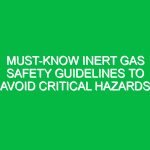“`html
Must-Know Guidelines for Incentivizing Safety Reporting Effectively
Introduction
Good morning team! Today, we’re diving into a crucial topic that directly impacts our Workplace Safety: Incentivizing Safety Reporting. Safety reporting is not just a regulatory requirement; it’s a vital component of our organizational culture and the well-being of every employee. The more we report safety concerns, the safer our workplace becomes. Let’s explore how we can effectively incentivize safety reporting to create a safer Environment for everyone.
Understanding Incentivizing Safety Reporting
Incentivizing safety reporting refers to the strategies and practices used to encourage employees to report Hazards, near misses, and unsafe conditions without fear of repercussions. It is crucial for several reasons:
- Enhances Safety Culture: When employees feel encouraged to report safety issues, they contribute to a proactive safety culture.
- Prevents Accidents: Early identification of Hazards can prevent accidents and injuries.
- Boosts Morale: Knowing that their concerns will be taken seriously increases employee morale and trust in management.
Common misconceptions include the belief that reporting will lead to blame or punishment. It’s essential to shift this mindset to one where reporting is seen as a positive action that contributes to everyone’s safety.
Key Hazards, Risks, and Safety Considerations
Incentivizing safety reporting is not without challenges. Here are some specific hazards and risks associated with failing to encourage safety reporting:
- Underreporting of Incidents: When employees don’t feel safe reporting, hazards can persist, leading to accidents.
- Increased Workplace Injuries: Unreported risks can result in injuries that affect productivity and employee health.
- Legal and Financial Risks: Non-compliance with safety reporting Regulations can lead to fines and liability issues.
Ignoring these risks can have real-world consequences, such as increased healthcare costs, loss of productivity, and damage to our reputation as a safe workplace.
Best Practices, Procedures, & Actionable Advice
To effectively incentivize safety reporting, here are some Best Practices you can implement:
1. Create a Safety Reporting System
Establish a clear and accessible reporting system that allows employees to report safety concerns anonymously. This could include:
- Online reporting tools
- Safety suggestion boxes
- Dedicated safety hotlines
2. Recognize and Reward Reporting
Implement recognition programs that reward employees for reporting safety incidents or near misses. This could involve:
- Monthly safety awards
- Public acknowledgment in meetings or newsletters
- Incentive bonuses for consistent reporting
3. Provide Training and Resources
Offer training sessions that emphasize the importance of safety reporting and how to do it effectively. Use real-life case studies to illustrate the impact of reporting on safety outcomes.
4. Foster Open Communication
Encourage open communication between employees and management. Regularly discuss safety reports in team meetings to demonstrate that management values feedback and is taking action based on reports.
Real-World Example
Consider the case of a manufacturing plant that implemented an anonymous safety reporting system. Initially, employees were hesitant to report issues. However, after implementing a reward system for reported near misses, the number of reports increased by 50% in three months. This led to the identification and remediation of several hazards, resulting in a significant reduction in workplace injuries.
Regulations, Standards, and Compliance
Understanding and complying with relevant safety regulations is crucial. Familiarize yourself with:
- OSHA Standards: These regulations outline the requirements for maintaining a safe workplace.
- ISO Standards: These provide guidelines for establishing effective safety management systems.
- Company Policies: Be aware of internal policies that govern safety reporting and employee rights.
Compliance is not just about avoiding penalties; it’s about protecting our workforce and fostering a culture of safety.
Employee Engagement & Discussion
Now that we’ve covered some guidelines, I want to hear from you! Let’s discuss:
- What safety challenges have you encountered related to reporting?
- How can we improve our current safety reporting system?
- Do you feel comfortable reporting safety concerns? Why or why not?
Your feedback is invaluable in shaping our safety culture. Remember, every voice matters in making our workplace safer.
Conclusion & Key Takeaways
Incentivizing safety reporting is essential for building a proactive safety culture. By creating an environment where employees feel safe and valued for reporting, we can prevent accidents and injuries. Remember these key takeaways:
- Establish clear, accessible reporting processes.
- Recognize and reward safety reporting to encourage participation.
- Provide ongoing training and resources to empower employees.
- Foster open communication to reinforce trust and transparency.
Thank you all for your attention and commitment to making our workplace safer. Let’s prioritize safety and continue to support each other in reporting hazards and improving our practices!
“`


